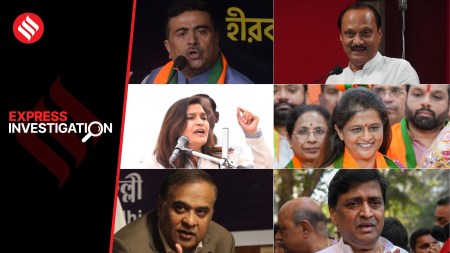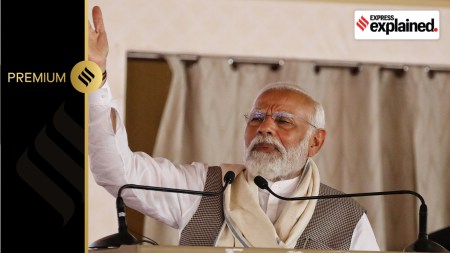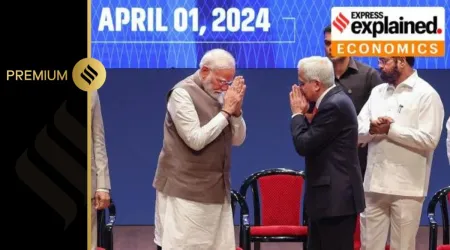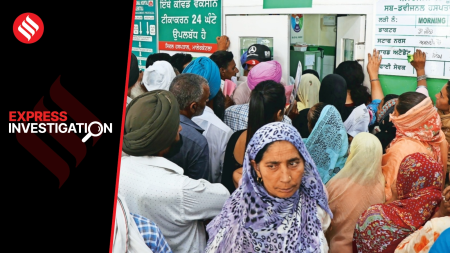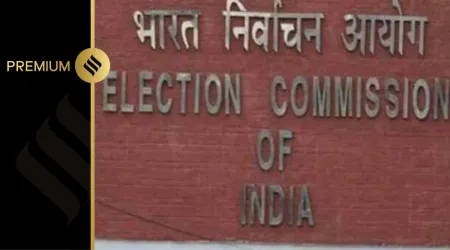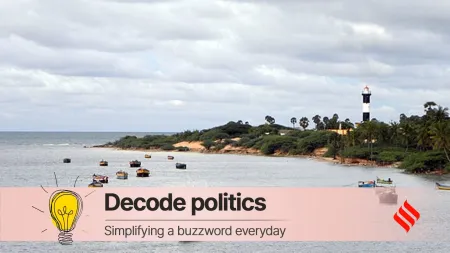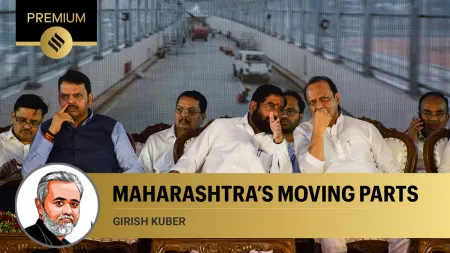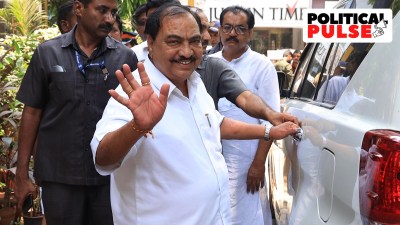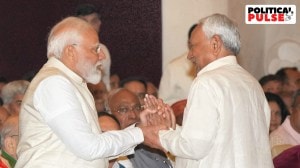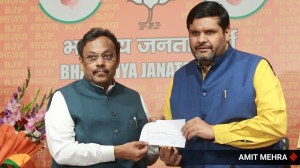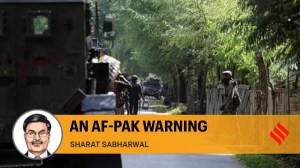- India
- International
UPSC Key— 3rd April, 2024: Kallakkadal, India’s new geopolitics, Heatwaves and more
Exclusive for Subscribers from Monday to Friday: How Kallakkadal and Heatwaves are relevant to the UPSC Exam? What significance do topics like India's new geopolitics and its Russian oil imports have for both the preliminary and main exams? You can learn more by reading the Indian Express UPSC Key for April 3, 2024.
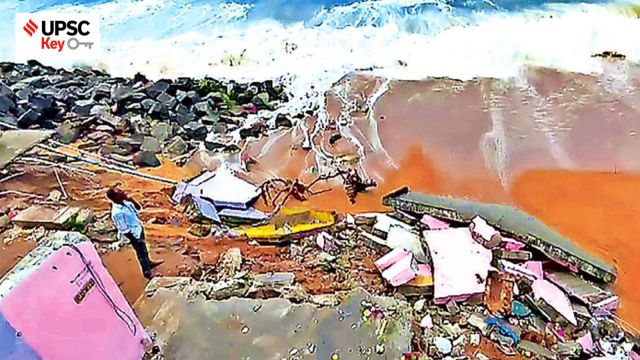 Houses damaged due to a Kallakkadal event in Kollam on Tuesday. Find more in today's UPSC Key. (ANI)
Houses damaged due to a Kallakkadal event in Kollam on Tuesday. Find more in today's UPSC Key. (ANI)Important topics and their relevance in UPSC CSE exam for April 3, 2024. If you missed the April 2, 2024 UPSC CSE exam key from the Indian Express, read it here.
THE EXPLAINED PAGE
Syllabus:
Preliminary Examination: Geography of India
Mains Examination: GS 1: Important Geophysical Phenomena
• What’s the ongoing story- High sea waves, commonly known as swell waves, have inundated hundreds of dwellings along Kerala’s coast. Alappuzha, Kollam, and Thiruvananthapuram districts are among the most severely hit. Authorities have established aid camps for affected local communities.
• KEY TAKEAWAYS
What is Kallakkadal?
— Kallakkadal is essentially coastal flooding during the pre-monsoon (April-May) season by swell waves on the southwest coast of India.
— The term Kallakkadal, used by local fishermen, is a combination of two Malayalam words, including Kallan and Kadal. “Kallan means thief and Kadal means sea.
— In 2012, the term was formally approved by the United Nations Educational, Scientific and Cultural Organization (UNESCO).
• Causes of Kallakkadal

— It is caused by waves that are formed by an ocean swell, hence the name swell surge.
— Ocean swells occur not due to the local winds, but rather due to distant storms like hurricanes, or even long periods of fierce gale winds.
— During such storms, massive amounts of energy are transferred from the air to the water, resulting in the development of extremely high waves.
— Such waves can travel thousands of kilometres from the storm’s centre before striking the beach.
• For Your Information:
— INCOIS has stated high waves will move to the Tamil Nadu coast on Tuesday night. It has alerted people in coastal areas vulnerable to sea erosion to take precautionary steps and ensure the safety of fishing vessels.
• Points to ponder:
— Why is Kallakkadal different from Tsunami?
(Thought Process: Tsunami (a Japanese word that means “harbour wave”) is a series of giant ocean waves caused by earthquakes or volcanic eruptions under the ocean. When an earthquake takes place under the ocean, a large chunk of the ocean floor can suddenly move upward or downward, leading to a sudden displacement of a large volume of water, thereby causing tsunami waves.)
— What is INCOIS?
— What are local winds? By what names local winds are known in different states?
• MCQ related to topic:
Kallakkadal was recently in the news. It is associated with:
(a) Local term used for heat waves
(b) Coastal flooding during the pre-monsoon
(c) Cyclone originated in Arabian Sea
(d) Backwaters of Kerala
THE EDITORIAL PAGE
Syllabus:
Preliminary Examination: Current events of national and international importance.
Mains Examination: GS-II: India and its neighbourhood- relations.
Bilateral, regional and global groupings and agreements involving India and/or affecting India’s interests.
Important International institutions, agencies and fora- their structure, mandate.
• What’s the ongoing story- C Raja Mohan writes: Delhi’s surprising focus on Katchatheevu, an island in the narrow strip of waters between India and Sri Lanka, is a part of the ruling BJP’s determination to break into Tamil Nadu’s electoral map. Hopefully, the potential negative consequences for Delhi’s improving ties with Colombo are manageable. But zooming out of Katchatheevu to the audit of Indian foreign policy over the last decade, we find island states and territories from the South Pacific to the African coast have become new nodes in India’s changing strategic geography.
• The Central Question: Katchatheevu and beyond, what is the focus of India’s new geopolitics?
• Prerequisites:
— International Institutions/Forums to look for:
- SCO
- QUAD
- SAARC
- Shangri La Dialogue
- EFTA
— Map Work:
- Katchatheevu
- Maldives
- Papua New Guinea
- Agalega Island
- Nordic, Baltic countries
- Zomia and Khorasan
• KEY TAKEAWAYS
— Whether it is the Maldives that now occupies much Indian mind space in the growing maritime joust with China, or Delhi’s new engagement with the resource-rich Papua New Guinea in the Pacific Islands, the joint development of infrastructure on the Agalega island of Mauritius, the collaboration with Australia in the eastern Indian Ocean islands, or the NDA government’s focus on developing the Andamans to our east and the Lakshadweep to the west, islands have emerged as an important part of India’s new geopolitics.
— “Indo-Pacific”: The idea was first proposed by the late Japanese Premier Abe Shinzo, in a speech to the Indian Parliament in 2007. Sceptics in Delhi saw the Indo-Pacific as an “American plot” to “entrap” India into “containing” China. It took over a decade after Abe’s call for India to formally embrace the Indo-Pacific idea. The Indo-Pacific is now well-established in the Indian discourse, and so is its institutional anchor, the Quad, which brings together Australia, India, Japan and the US.
— The idea of “Eurasia”: The continental cousin of the maritime Indo-Pacific — has not gained equal currency in the Indian strategic discourse but is now part of India’s new diplomatic vocabulary. If Japan and the US popularised “Indo-Pacific”, Russia has driven the “Eurasian” idea. As a great power straddling Europe and Asia, Russia sees the vast Eurasian landmass as its natural sphere of influence. The Shanghai Cooperation Organisation, built jointly by Russia and China, was the institutional expression of the Eurasian idea.
• Point to ponder: Europe has long been a neglected geography in independent India’s international relations. That has changed in the last decade. Discuss.
(Thought Process: Europe is India’s second-largest trading partner and third-largest export destination. Last month, India signed a free trade agreement with the EFTA, constituted by four small but significant countries — Iceland, Liechtenstein, Norway and Switzerland.
The Nordic region, the Nordic-Baltic coalition, the Med 9 of southern European nations, and the Caucasus have emerged as new geographies of consequence for India in Europe and around it.
Last week’s visit of Dmytro Kuleba, the first by Ukraine’s foreign minister, underlines India’s potential role in shaping war and peace in Central Europe, whose turbulent politics have triggered two world wars and threatens to unleash a third.
The plans for an economic corridor between India and Europe via the Middle East, the Abraham Accords, the Gaza war, the rise of the Arab Gulf, India’s deepening partnership with the UAE and Saudi Arabia, the presence of nearly 20 Indian naval ships outside the Red Sea region today, and the growing engagement with Africa is producing a more integrated view of the Middle East, Africa, the eastern Mediterranean and the Western Indian Ocean. These were often seen as separate categories in the past.)
• Point to ponder: SAARC’s failure has persuaded India to focus on sub regional cooperation. Discuss.
• For Your Information:
Two areas which might draw more of India’s strategic attention: Zomia and Khorasan.
- Zomia– an academic term for a region where the high lands of North East India, South West China, and South East Asia meet. It’s a region where centralised state control has been traditionally weak and is full of minority populations, some of whom straddle across formal state borders.
- Khorasan in Persian means the land of the rising sun. It refers to Persia’s eastern borderlands, including parts of modern Pakistan, Afghanistan and Central Asia.
• Other Important Article Covering the same topic:
Strategy and foreign affairs for India in 2024: dealing with realities, looking at opportunities
Syllabus:
Preliminary Examination: Geography
Mains Examination: GS-I: Important Geophysical phenomena
• What’s the ongoing story- The effects of climate change on the Indian summer have been obvious for at least a decade. In most parts of the country, the spring season has shrunk. In 2022, the country experienced its hottest March since 1901. Last year, too, heatwaves started in early March, and many areas reported temperatures that were higher than average. This year, several parts of south India experienced a hotter-than-usual March.
• The Central Question: In recent years, studies have underlined the need to fine-tune the maximum temperature-based criteria to declare a heat wave. Why do we need to Act Now?
• Prerequisites:
Institutions to look for:
(a) IMD
(b) NDMA
(c) NCRB
• KEY TAKEAWAYS:
— Climate change is also increasing the frequency and intensity of extreme weather events. On Monday, the India Meteorological Department (IMD) warned that heatwave spells could last 10-20 days, instead of four to eight days.
— In one lethal week in May 2010, a heat wave claimed more than 800 lives in Ahmedabad. The tragedy pushed the city’s municipality to partner with the Indian Institute of Public Health and American academies to develop the country’s first heat action plan (HAP) in 2013.
— Last year, a sunstroke-related tragedy in Navi Mumbai, which claimed 13 lives, shone a light on the need for more local-level weather observatories — the satellite city sources its data from a station about 30 km away.
— In recent years, studies have underlined the need to fine-tune the maximum temperature-based criteria to declare a heat wave. There is a growing realisation that thresholds to declare heat waves must be tailored for local conditions — for instance, factoring in humidity while estimating the stress exerted by extreme heat. Dealing with climate change will require several course corrections. There’s no time to be lost after the IMD’s latest alert.
• For Your Information:
— What is a Heat Wave? A Heat Wave is a period of abnormally high temperatures, more than the normal maximum temperature that occurs during the summer season in the North-Western parts of India. Heat Waves typically occur between March and June, and in some rare cases even extend till July. The extreme temperatures and resultant atmospheric conditions adversely affect people living in these regions as they cause physiological stress, sometimes resulting in death.
— When does India declare a heatwave?
According to the Health Ministry, a heatwave is declared when the maximum temperature of a station reaches at least 40°C or more for plains, 37°C or more for coastal stations, and at least 30°C or more for hilly regions.
— Based on departure from normal temperatures, the following criteria are used to declare a heatwave:
Heatwave: Departure from normal is 4.5°C to 6.4°C
Severe Heatwave: Departure from normal is 6.4°C
And, based on actual maximum temperature in plains, the following criteria is considered:
Heatwave: When the actual maximum temperature ≥ 45°C
Severe Heatwave: When actual maximum temperature ≥47°C
• Points to ponder:
— What is a heat dome? What is the relationship between heat domes and the jet stream?
— What is a cold wave?
— What are marine heat waves? What is the impact of marine heat waves on ocean life?
• Other Important Article Covering the same topic:
Heat domes, anticyclones and climate change: What’s causing heat waves across the world?
What are marine heat waves, which have gripped parts of the world’s oceans this summer?
All you need to know about the heatwave, how to protect yourself
THE IDEAS PAGE
Syllabus:
Preliminary Examination: Current events of national and international importance.
Mains Examination: GS-II: Government policies
• What’s the ongoing story- Sujan Chinoy writes: India’s defence ecosystem has undergone transformations in several key areas in recent years. Key institutional and policy changes have spurred defence indigenisation, domestic capital procurement and defence exports.
In an era of uncertainty, the goals of Atmanirbhar Bharat (self-reliant India) and Make In India would mitigate risks on account of disruption or manipulation of critical supply chains — the kind of challenges that have constrained Ukraine in its conflict with Russia.
• Prerequisites
— Important terms/topics to look for:
(a) The Srijan Indigenisation Portal
(b) INS Vikrant aircraft carrier
(c) Project 17A
(d) Defence Excellence (iDEX) initiative and iDEX Prime
• For Your Information:
— The Defence Acquisition Procedure (DAP) 2020 prescribed 50 per cent indigenous content (IC) in procurement contracts. To encourage foreign original equipment manufacturers (OEMs) to set up maintenance and manufacturing facilities in India, a new procurement category — Buy (Global-Manufacture in India) — has been introduced. This will enable ab initio indigenisation of spare parts. The Union Ministry of Defence (MoD) has released several “Positive Indigenisation Lists” that mention items that must be procured only from domestic sources. Nearly 5,000 items currently imported by the Defence Public Sector Units (DPSUs) and the three Services figure in this list.
— In 2019, the Stockholm International Peace Research Institute (SIPRI) placed India among the top 25 arms exporters (at 23rd position) for the first time. India has set a defence exports target of Rs 35,000 crore by 2025.
— Equal career opportunities to women in the armed forces: The government’s Nari Shakti initiative has played a major role in the transformation of the nation, especially the armed forces. Sainik Schools, which have long served as grassroots institutions for recruitment in the armed forces, are no longer a male bastion. The doors of the National Defence Academy have also been thrown open to women. The number of women officers has risen sharply in recent years.
• Other Important Article Covering the same topic:
Syllabus:
Preliminary Examination: Indian Geography
Mains Examination: GS 2: India and its neighbourhood- relations
• What’s the ongoing story- Before voting for the Lok Sabha election in Tamil Nadu, the BJP has reignited the decades-old Katchatheevu issue, accusing the Indira Gandhi government of “callously giving away”, as the Prime Minister said in a post on social media, the island to Sri Lanka.
• Key Takeaways:
— Katchatheevu is a 285-acre uninhabited Indian Ocean territory.
— The island is known for Antony’s Church which Lankan and Indian pilgrims visit annually. It was built in 1905 by Ramnad merchant Seenikuppan Padayachi, intended as a halfway ground for Indo-Lankan fishers for drying nets or asylums during tempests.
— The island was under the control of the kingdom of the Ramanad Raja, a zamindari from 1795 to 1803 in Ramanathapuram in the Madras Presidency during British rule.
—The island was ceded by the Indira Gandhi government to the Sirimavo Bandaranaike Lankan administration in 1974.
— Katchatheevu is an unofficial battlefield between Indian Tamil fishers and a Sinhala-dominated Lankan navy.
• Points to ponder
— India-Sri Lanka fishermen issue
— Other Islands near Katchatheevu
• Other Important Articles Covering the same topic:
Katchatheevu and Wadge Bank: the story of two India-Sri Lanka agreements from a half century ago
Did Congress ‘give away’ Katchatheevu island to Sri Lanka?
• MCQ related to topic:
Katchatheevu Island isin the news. The Island is located in:
(a) Bay of Bengal
(b) Gulf of Kutch
(c) Gulf of Khambat
(d) Palk Strait
ECONOMY
India’s Russian oil imports flow heavy despite tighter sanctions
Syllabus:
Preliminary Examination: Indian Economy
Mains Examination: GS 2 and GS 3: Economic and Social Development, International Relations
• What’s the ongoing story- Tightening sanctions imposed by the United States (US) and other Western powers on Russia’s oil trade appear to have had no effect on India’s Russian oil purchases, with delivered volumes in March rising more than 6% over February levels to a four-month high of nearly 1.7 million barrels per day (bpd), accounting for one-third of New Delhi’s total oil imports for the month, according to preliminary data from commodity market analytics firm Kpler.
• For Your Information:
— In the most recent action against oil tankers over alleged violations of the G7 price cap of $60 per barrel on seaborne Russian petroleum, the US sanctioned Russia’s state-owned shipping firm Sovcomflot and 14 vessels linked with it on February 23.
— Indian refiners are reportedly refusing to accept oil transported by Sovcomflot tankers in an apparent attempt to avoid secondary sanction risk.
— According to a senior government official, the government does not want Indian refiners to openly defy the G7 pricing cap or engage in deals that may pose sanctions-related risks.
—This sparked widespread concern that Indian refiners’ purchases of Russian oil could fall. The statistics for March, however, presents a different picture.
— Indian buyers pay the all-inclusive landed price of crude and have no involvement in the shipping of the oil, which keeps them largely insulated from possible price cap-related complications.
— Indian refiners ramped up Russian oil purchases in the aftermath of Moscow’s February 2022 invasion of Ukraine. Prior to the war in Ukraine, Russia was a minor contributor to India’s oil imports, but it is now the country’s largest supply of petroleum, surpassing traditional giants Iraq and Saudi Arabia.
• Points to Ponder:
— What is the difference between OPEC and OPEC+?
— Which country is the biggest supplier of crude oil to India?
— Important places in news in Russia
— Bordering countries of Russia
• Other Important Articles Covering the same topic:
Russia remains India’s top oil exporter despite supply hitting 12-month low
India’s crude oil imports – Russia, Iraq gain at Saudi Arabia’s expense in September
• MCQ related to topic:
Consider the following countries:
1. Russia
2. Iraq
3. Saudi Arabia
What is the correct chronological order of crude oil supplier (in terms of volume from top to bottom) to India?
(a) 3—1—2
(b) 2—1—3
(c) 1—3—2
(d) 1—2—3
For any queries and feedback, contact manas.srivastava@indianexpress.com
Apr 04: Latest News
- 01
- 02
- 03
- 04
- 05



